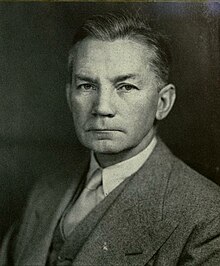
Back جيمس فورستال Arabic جيمس فورستال ARZ جیمز فورستال AZB Джэймс Форэстал Byelorussian James V. Forrestal German Τζέιμς Φόρεσταλ Greek James Forrestal Esperanto James Forrestal Spanish جیمز فورستال Persian James Forrestal Finnish
James Forrestal | |
|---|---|
 | |
| 1st United States Secretary of Defense | |
| In office September 17, 1947 – March 28, 1949 | |
| President | Harry S. Truman |
| Preceded by | Position established |
| Succeeded by | Louis A. Johnson |
| 48th United States Secretary of the Navy | |
| In office May 19, 1944 – September 17, 1947 | |
| President | |
| Preceded by | Frank Knox |
| Succeeded by | John Sullivan |
| United States Under Secretary of the Navy | |
| In office August 22, 1940 – May 16, 1944 | |
| President | Franklin D. Roosevelt |
| Preceded by | Position established |
| Succeeded by | Ralph Austin Bard |
| Personal details | |
| Born | James Vincent Forrestal February 15, 1892 Matteawan, New York, U.S. (now Beacon) |
| Died | May 22, 1949 (aged 57) Bethesda, Maryland, U.S. |
| Resting place | Arlington National Cemetery, Virginia, U.S. |
| Political party | Independent |
| Spouse |
Josephine Ogden Stovall
(m. 1926) |
| Children | 2, including Michael |
| Education | |
| Signature | |
| Military service | |
| Branch/service | United States Navy |
| Rank | Lieutenant |
| Battles/wars | World War I |
James Vincent Forrestal (February 15, 1892 – May 22, 1949) was the last Cabinet-level United States Secretary of the Navy and the first United States Secretary of Defense.[1]
Forrestal came from a very strict middle-class Irish Catholic family. He was a successful financier on Wall Street before becoming Undersecretary of the Navy in 1940, shortly before the United States entered the Second World War. He became Secretary of the Navy in May 1944 upon the death of his superior, Col. Frank Knox. President Franklin D. Roosevelt requested that Forrestal take the lead in building up the Navy. In 1947, after the end of the war, President Harry S. Truman appointed him the first secretary of the newly created Department of Defense. Forrestal was intensely hostile to the Soviet Union, fearing Communist expansion in Europe and the Middle East. Along with Secretary of State George C. Marshall, he strongly opposed the United States' support for the establishment of the State of Israel, fearing that this would alienate Arab nations which were needed as allies, and whose petroleum reserves were vital for both military and civilian industrial expansion.
Forrestal was a supporter of naval battle groups centered on aircraft carriers. He tried to weaken the proposed Department of Defense for the Navy's benefit, but was hard-pressed to run it from 1947 to 1949 after Truman named him Secretary of Defense. The two men were often at odds, and Truman forced Forrestal's resignation.
Thereafter, Forrestal's mental health rapidly deteriorated, declining to the point in which he underwent medical care for depression. While a patient at Bethesda Naval Hospital, Forrestal died by suicide from fatal injuries sustained after falling out of a sixteenth-floor window.
In 1954, the USN's new supercarrier was named USS Forrestal in his honor, as is the James V. Forrestal Building, which houses the headquarters of the United States Department of Energy. He is the namesake of the Forrestal Lecture Series at the United States Naval Academy and of the James Forrestal Campus of his alma mater Princeton University.
- ^ "James V. Forrestal – Harry S. Truman Administration". Office of the Secretary of Defense – Historical Office.
© MMXXIII Rich X Search. We shall prevail. All rights reserved. Rich X Search